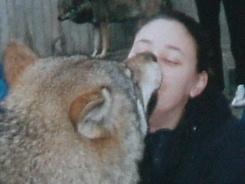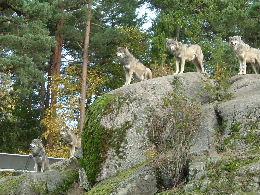Human-wolf interactions: the importance of hands-on meetings

by Anna Chowdhury
Introduction to master project

General information on Wolves (Canis lupus).
The wolf is the largest wild member of the dog family, although both size and colouring varies with the type of terrain they inhabit and what their main prey is. It was once the most widely spread species in the world, apart from us humans. Since they also are one of the most adaptable species, they have managed to adapt to all kinds of biotopes in the northern hemisphere (north of 20 latitude). The multitude of different life conditions has resulted in a number of variants of the wolf, and around 30 subspecies have been recognised.
The size of a wolf pack’s territory is just like pack size itself, dependent on the prey abundance in the area. On average the pack consists of 8-12 individuals, although during periods when prey is scarce, the pack may split up into smaller groups, sometimes temporarily but sometimes permanently.
The preferred prey by wolves are the large ungulates, like elk, moose and rein deer or caribou. Because of the animals ability to take down larger prey, the wolves can be considered as an umbrella species, because many other species, like birds and smaller carnivores, can benefit from the kill, especially in winter time.
The world’s population of wild wolves are slowly increasing, in some cases due to reintroduction programmes like in Yellowstone National Park or other conservation programmes (for report and progress of Yellowstone- project, see link below). It is estimated that roughly 150 000-200 000 individuals now roam in at least 40 nations of the world, with the status differing from region to region. Still however, it is a far cry from their former numbers.
Sweden and Norway together have approximately 100 wild wolves, far from the life sustaining, genetically different population of 500 individuals needed to avoid inbreeding. The low population number in Scandinavia are primarily due to high human-caused mortality, even though wolves have been protected by law in Scandinavia since the 1960s and 1970s.

Introduction to project
The surviving wolves of the world today are many times having a hard time. While the wolves ability to adapt to the presence of humans is evident, man’s ability to adapt to the wolf has been far less apparent throughout the years we have occupied the same areas. One reason for this is people’s long standing misconceptions and fear of the “Big Bad Wolf”.
To break down people’s prejudices and misbelieves surrounding these magnificent creatures and symbols of the untamed wilderness, a few research centres, animal parks and zoos around the world are trying to educate people and let them visit with ambassadors of the species. Through these ambassadors the people gain a better knowledge and understanding of the wolves, and thereby in the long run increase the acceptance of the wolves in the wild. One of the places which allows people to have a hands-on meeting with wolf ambassadors are Kolmården Zoo and Safari park, where my study was made.
Hands on experiences can be considered as an environmental enrichment for wolves in captivity, and although these animals generally have no problem with stereotypy they may have an issue of passivity. The first part of my work I made an effort to determine if the general activity and social interactions in the focal group is affected by these hands-on meetings.
In the second part of my work I have targeted the people having the hands-on experiences. I wanted to determine whether or not these meetings had the power to alter peoples attitudes and perceptions of the wolf, and thereby increase the tolerance for these animals in the wild and serve as a tool for conservation of the species.
Responsible for this page:
Director of undergraduate studies Biology
Last updated:
